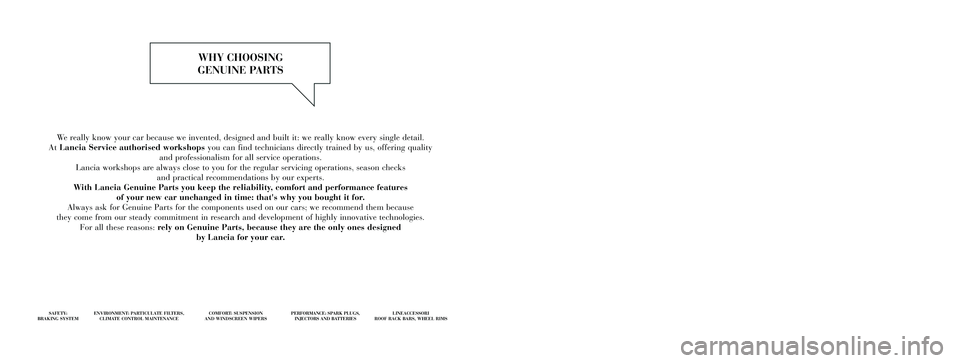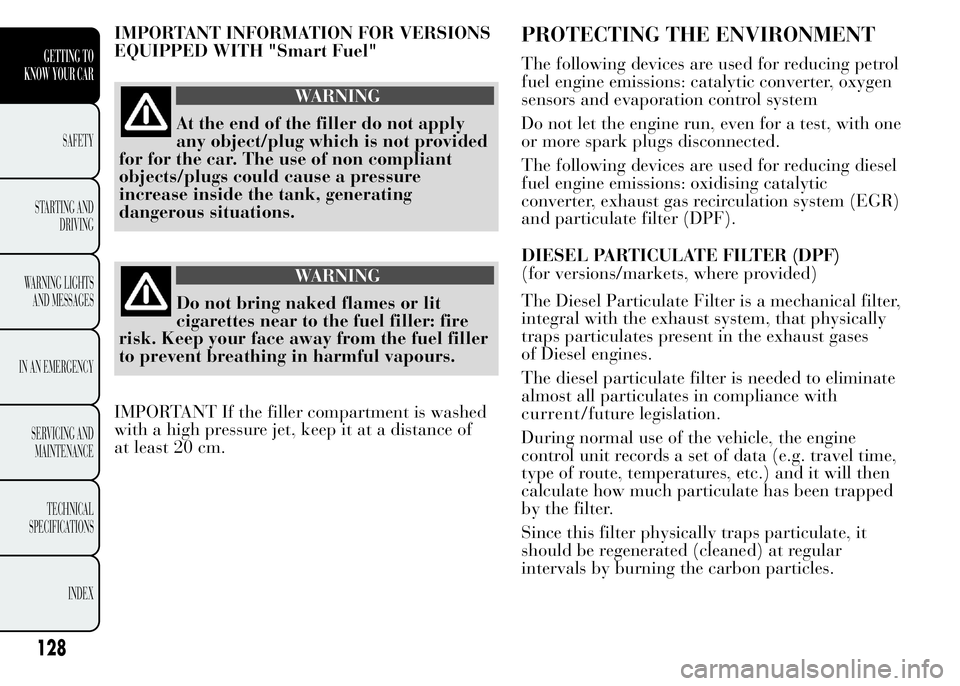spark plugs Lancia Ypsilon 2015 Owner handbook (in English)
[x] Cancel search | Manufacturer: LANCIA, Model Year: 2015, Model line: Ypsilon, Model: Lancia Ypsilon 2015Pages: 315, PDF Size: 10.85 MB
Page 2 of 315

We really know your car because we invented, designed and built it: we really know every single detail.
At Lancia Service authorised workshopsyou can find technicians directly trained by us, offering quality
and professionalism for all service operations.
Lancia workshops are always close to you for the regular servicing operations, season checks
and practical recommendations by our experts.
With Lancia Genuine Parts you keep the reliability, comfort and performance features
of your new car unchanged in time: that's why you bought it for.
Always ask for Genuine Parts for the components used on our cars; we recommend them because
they come from our steady commitment in research and development of highly innovative technologies.
For all these reasons: rely on Genuine Parts, because they are the only ones designed
by Lancia for your car.
SAFETY:
BRAKING SYSTEMENVIRONMENT: PARTICULATE FILTERS,
CLIMATE CONTROL MAINTENANCECOMFORT: SUSPENSION
AND WINDSCREEN WIPERS PERFORMANCE: SPARK PLUGS,
INJECTORS AND BATTERIESLINEACCESSORI
ROOF RACK BARS, WHEEL RIMS
WHY CHOOSING
GENUINE PARTS
Cop nuova Ypsilon Lum GB 17/04/14 08:07 Pagina 2
Page 132 of 315

IMPORTANT INFORMATION FOR VERSIONS
EQUIPPED WITH "Smart Fuel"
WARNING
At the end of the filler do not apply
any object/plug which is not provided
for for the car. The use of non compliant
objects/plugs could cause a pressure
increase inside the tank, generating
dangerous situations.
WARNING
Do not bring naked flames or lit
cigarettes near to the fuel filler: fire
risk. Keep your face away from the fuel filler
to prevent breathing in harmful vapours.
IMPORTANT If the filler compartment is washed
with a high pressure jet, keep it at a distance of
at least 20 cm.
PROTECTING THE ENVIRONMENT
The following devices are used for reducing petrol
fuel engine emissions: catalytic converter, oxygen
sensors and evaporation control system
Do not let the engine run, even for a test, with one
or more spark plugs disconnected.
The following devices are used for reducing diesel
fuel engine emissions: oxidising catalytic
converter, exhaust gas recirculation system (EGR)
and particulate filter (DPF).
DIESEL PARTICULATE FILTER (DPF)
(for versions/markets, where provided)
The Diesel Particulate Filter is a mechanical filter,
integral with the exhaust system, that physically
traps particulates present in the exhaust gases
of Diesel engines.
The diesel particulate filter is needed to eliminate
almost all particulates in compliance with
During normal use of the vehicle, the engine
control unit records a set of data (e.g. travel time,
type of route, temperatures, etc.) and it will then
calculate how much particulate has been trapped
by the filter.
Since this filter physically traps particulate, it
should be regenerated (cleaned) at regular
intervals by burning the carbon particles.
128
GETTING TO
KNOW YOUR CAR
SAFETY
STARTING AND
DRIVING
WARNING LIGHTS
AND MESSAGES
IN AN EMERGENCY
SERVICING AND
MAINTENANCE
TECHNICAL
SPECIFICATIONS
INDEX
current /future legislation.
Page 224 of 315

220
GETTING TO KNOW
YOUR CAR
SAFETY
STARTING AND
DRIVING
WARNING LIGHTS
AND MESSAGES
IN AN EMERGENCY
SERVICING AND
MAINTENANCE
TECHNICAL
SPECIFICATIONS
INDEX
Thousands of miles 9 18 27 36 45 54 63 72 81 90
Thousands of kilometres 15 30 45 60 75 90
105 120 135 150
Years12345678910
Change engine oil and oil filter (or every two years)
(1)●●●●●
Change spark plugs●●●●●
Replace the auxiliary drivebelt(s)
(2)●
Replace the toothed timing drive belt (0.9 TwinAir
85 HP versions excluded)
(2)●
Replace air cleaner cartridge
(3)●●●●●
Replace brake fluid●●●●●
Replace passenger compartment cleaner
(3) (O) (●)O●O●O●O●O●
(1) If the vehicle is used mainly on urban routes or the annual distance travelled is less than 10,000 km, the engine oil and
engine oil filter must be changed every year.
(2) Areas that are not dusty: advised maximum mileage 120,000 km. Regardless of the mileage, the belt must be replaced
every 6 years.
Dusty areas and/or demanding use of the car (cold climates, town use, long periods of idling): advised maximum mileage
60,000 km. Regardless of the mileage, the belt must be replaced every 4 years.
(3) If the car is used in dusty areas, this cleaner must be replaced every 15,000 km
(O) Recommended operations
(●) Mandatory operations
Page 248 of 315

ENGINE
Versions 0.9 TwinAir 85 HP 1.2 8V 69 HP 1.3 16v MultiJet
Engine code 312A2000 169A4000 199B1000
Cycle Otto Otto Diesel
Number and arrangement of
2 in line 4 in line 4 in line
Piston diameter and travel (mm) 80.5 x 86.0 70.8 x 78.86 69.6 x 82
Total displacement (cm³) 875 1242 1248
Compression ratio 10 11,1 16,8
Maximum power (EEC) (kW)
62,5/57
(*)51 70
Maximum power (EEC) (HP)
85/77,5
(*)69 95
corresponding engine speed (rpm) 5500 5500 4000
Max torque (EEC) (Nm)
145/100
(*)102 200
Maximum torque (EEC) (kgm)
14,8/10,2
(*)10,4 20,4
corresponding engine speed (rpm)
1900/2000
(*)3000 1500
Spark plugs NGK PLKR9C8NGK ZKR7A-10 or
CHAMPION
RA8MCX4-
FuelUnleaded petrol 95
RON (EN 228 specifi-
cation)Unleaded petrol 95
RON (EN 228 specifi-
cation)Diesel for automotive
engines (EN 590 speci-
fication)
(*)With ECO button pressed
244
GETTING TO KNOW
YOUR CAR
SAFETY
STARTING AND
DRIVING
WARNING LIGHTS
AND MESSAGES
IN AN EMERGENCY
SERVICING AND
MAINTENANCE
TECHNICAL
SPECIFICATIONS
INDEX
cylinders